Ah, Paris in the Spring!
One EMCS Member, who will simply be known as "Senior
EMC Consultant," tells of being called to Chrysler-Semca
in Paris, France, twice in one spring season. In this
particular Chrysler plant, the main-frame computer room
was surrounded by 200 arc welders. On Senior EMC Consultant's
first trip to Paris, he was brought in to determine why
the entire computer system would go into "clocks-off"
mode when one particular welder was operational. After
a short investigation with an ESD gun, he discovered that
on one cable (out of 650), the cable shielding was terminated
to pin 99 instead of pin 100 (ground pin). The culprit
cable failed the ESD test at 200 V instead of 10 kV. The
Senior EMC Consultant reminisces that he "remained
in Paris for three more days, at the company's request
and expense. They wanted to make sure that I had truly
solved the problem. Touring Paris in the springtime was
wonderful!"
On his second trip to Paris that spring, the same computer
system was again experiencing another mysterious "clocks-off"
failure. As Senior EMC Consultant walked around the system,
he found that a logic analyzer had been retrofitted into
one of the cabinets. The analyzer, located outside of
the cabinet, had been connected to various memory circuits
of the computer by coax cables which entered the shielded
cabinet. However, the cables were not grounded to the
cabinet. To trouble-shoot what he suspected to be the
problem, Senior EMC Consultant moved a fluorescent magnifying
lamp into close proximity of the cables and switched the
lamp on. The system immediately went into "clocks-off"
mode. The coax cables were removed from the system and
all was well. The Senior EMC Consultant muses, "the
company again insisted that I remain on contract for an
extra three days to ensure that my recommendations had
solved the problem. I ate my way through Paris."
|
Central New England
A Chapter meeting was held on Wednesday, October 16th, 2002. The
speaker was Dr. Lothar (Bud) Hoeft, Independent Consultant and
Distinguished Lecturer of the IEEE EMC Society. His presentation
discussed the topic: "Experimental and Theoretical Analysis
of Electromagnetic Shielding of Enclosures." According to
Dr. Hoeft, one use of conductive enclosures is to keep electromagnetic
fields where they belong. The surface magnetic field attenuation
(MFA) of a wide range of enclosures and panels has been measured.
The speaker discussed a simple theory developed to explain and
extend the results. 11 IEEE EMCS members attended the meeting.
The low attendance was probably the result of a severe Northeast
storm moving through the area prior to and during the meeting.
Monthly committee meetings are being held to plan for the 2003
IEEE EMC Symposium to be held in Boston this summer. The Symposium
Committee members are all CNEC EMCS members. Boris Shusterman
and John Clarke will be Chapter Co-Chairs for 2003 and the election
will be held at the next Chapter meeting (probably in March 2003).
Central Texas
2002 was an outstanding year for the Central Texas Chapter of
the IEEE EMC Society. The activities included an EMC/Product Safety
Vendor Expo, a tour of the new facilities at ETS-Lindgren, in
Cedar Park, Texas, and two social dinners. A variety of notable
speakers addressed the chapter members. The chapter wishes to
thank the following for volunteering their valuable time to share
their experience and insights: Dr. Michael Foegelle (ETS-Lindgren),
Mark DeKirmandjian (TDK), Al Ridilla (BMI-Parkway), Dr. Lothar
"Bud" Hoeft (EMC Society Distinguished Lecturer), Michelle
Cook (IBM), Todd Steigerwald and Ross Carlton (Electromagnetic
Design and Test, LLP), Dr. Maria Sabrina Sarto (University of
Rome "La Sapienza"), Robert W. Holland (Hamilton and
Terrile, LLP), and Colin Brench (Compaq/HP; EMC Society Distinguished
Lecturer). Thanks go to John O'Brien and National Instruments
for again allowing the chapter to call the NI facilities "home."
Special thanks also go to Dianne Brown, Charles Farris, and Mark
Prchlik for their hard work on the EMC/Product Safety Vendor Expo.
Finally, the chapter officers wish to thank the area members for
their support, and for making 2002 such a success. We look forward
to working with all of you in 2003 to ensure that the chapter
continues to grow and serve its members with distinction. For
updated event information, please visit the chapter website at
https://ewh.ieee.org/soc/emcs/chapters/centraltexas/
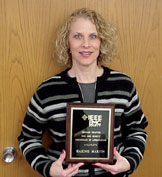 |
| Maxine Martin of DLS Electronics
was recognized by the Chicago Chapter in appreciation for
her "years and years" of cheerful, professional
service. |
Chicago
Maxine Martin of DLS Electronics received an award from Chapter
Chair Ray Klouda, for years and years of appreciation, at the
Chapter's "First Annual Christmas Party," held at Dave
& Busters restaurant. It was very well attended with over
50 people in attendance. The Christmas game was won by Brandon
Krozel, and the pool game was won by John Modica. In addition,
many certificates were given away for various games that were
held. We all look forward to next year and the Second Annual Christmas
Party. Frank Krozel, Treasurer of the Chapter, invites everyone
to come to Chicago for the 5th Annual Chicago EMC MiniSymposium
on Tuesday, May 20. Check out www.ewh.ieee.org/soc/emcs/chicago/
for more information about Chicago EMC Chapter activities.
Germany
At the German Chapter's last meeting, we elected a new Chapter
Board of Directors. These officers will serve for a period from
January 1, 2003 to December 31, 2004. The new Board consists of
the following persons: Prof. Dr.-Ing. Heyno Garbe, Chairman, Universität
Hannover; Dipl.-Ing. Diethard E. C. Möhr, Vice-Chairman,
Siemens AG; Dr.-Ing. Frank Sabath, Treasurer, WIS ABC; Dr. Frank
Gronwald, Technical Activities, Universität Magdeburg. Other
At Large BoD Members include: Prof. Dr.-Ing. Dr. E.h. Jan Luiken
ter Haseborg of the TU Hamburg-Harburg and Dipl.-Ing. Friedrich-Wilhelm
Trautnitz of Albatross Projects GmbH.
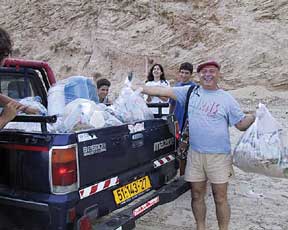 |
|
After the Israel Chapter Workshop,
Anatoly and Alex volunteered to clean the beautiful coastline
of Israel.
|
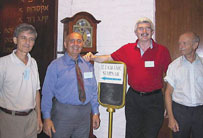 |
|
Speakers at the Israel Chapter Workshop,
from left to right: Dr. Alex Axelrod, Dr. Anatoly Tsaliovich,
Elya B. Joffe, and Oren Hartal.
|
Israel
On September 2-3, 2002 the Israel IEEE EMC Chapter organized a
two-day workshop with ILTAM, Israel's Users Association in the
Electronic Industry. The Workshop, entitled "Advanced EMC
Design Techniques For High Speed Electronics," took place
in Hertzeliya, Israel, and featured as the initiator and leader
of the Workshop, Dr. Anatoly Tsaliovich, USA, with guest speakers
from Israel: Dr. Alexander Axelrod, Mr. Elya Joffe, and Mr. Oren
Hartal. Each speaker is well known and recognized in Israel and
abroad.
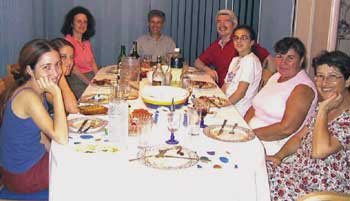 |
| Following the conclusion
of the Israel Chapter Workshop, the Axelrod, Joffe and Tsaliovich
families enjoyed an evening of leisure at Alex's home, with
(almost) no discussions on EMC and EMC'2003 (Istanbul) Symposium.
Elya is the Symposium Chairman, Alex is the Technical Program
Chair and Anatoly is the Chairman of the International Advisory
Technical Council and Editorial Board (IATC/EB). |
Beyond the technical content, the theme of the workshop was "The
First Technical Workshop in Benefit of Terror Victims." While
the technical merits of this Workshop were many, its organizers
and participants demonstrated their support for the victims of
terrorism. All proceeds from the workshop were directed to benefit
victims of terrorism.
The technical program of the workshop addressed the EMC needs
of high-speed electronics. Designers, managers, and users, as
well as leading EMC experts from the United States and Israel
presented a detailed analysis of selected high-speed electronics
EMC problems and suggested appropriate, often innovative and original
practical design techniques. The Workshop scope spanned the subjects
from EMC design rationale and strategies to EMI reduction spectrum
and signal management to system configuration, grounding and shielding,
to PCB layout and discrete electromagnetic decoupling.
The following specific papers were presented in the course of
the full two days:
"EMC Design Rationale and Strategies In High Speed Electronics"
by Dr. Anatoly Tsaliovich
"Spectrum and Signal Management for EMC" by Dr.
Anatoly Tsaliovich
"EMI Coupling Mechanisms and What to Do About Them"
by Dr. Anatoly Tsaliovich
"A Note on Interconnection Problems and Solutions In High
Speed Electronics" by Dr. Anatoly Tsaliovich
"EMI Effects Due to Unbalance in Signal and Power Ports"
by Dr. Alex Axelrod
"The Principles of Path of Least Inductance in Circuit
and Grounding Design" by Elya Joffe
"System Design Considerations and PCB Layout for EMI Protection"
by Dr. Anatoly Tsaliovich
"Magnetic Shielding in Power Plants for Large Facilities"
by Oren Hartal
"Discrete Decoupling Techniques for System and PCB EMC
Design" by Dr. Anatoly Tsaliovich
"A Note on System Model of Electromagnetic Shielding"
by Dr. Anatoly Tsaliovich
The Workshop was concluded with a forum of Q&A and Panel Discussions.
Over 60 IEEE members and guests attended the event and overwhelmingly
declared it to be a success!
 |
| The Introduction Slide presented
at the Israel Chapter's recent workshop. |
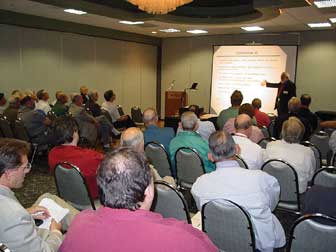 |
| Dr. Lothar "Bud"
Hoeft gives one of his popular presentations to a full house
at the Long Island Chapter meeting in October. |
Long Island
The Long Island (LI) New York chapter is pleased to report that
it is back in operation. When the previous long-time Chapter Chair,
Bob Berkovitz, moved out of town, the realization came that he
was simultaneously the Chapter Chair, Vice Chair and Secretary.
The LI IEEE EXCOM then appointed Richard Mohr and Bruce Willard
as Co-Chairs and charged them with bringing the Chapter back into
operation. They enlisted Jim Colotti of Telephonics Corporation
and a recent addition to the EMC Society, to construct a web page
for the Chapter and it is now in operation: https://www.ieee.li/emc.htm.
The kick-off meeting was held on October 8, 2002 at the Holiday
Inn in Plainview, LI. EMCS Distinguished Lecturer, Dr. Lothar
(Bud) Hoeft, was invited and gave his presentation, "A View
of Electromagnetic Life Above 100 MHz (An Experimentalist's Intuitive
Approach)." Dr. Hoeft addressed the important area of parasitic
circuit elements and their undesirable EMC effects. He expertly
avoided complex electromagnetic equations and concentrated on
measurement approaches and sanity checks. The attendance of 41
included 20 members of the EMC Society. The Long Island EMC Chapter
continued with our bi-monthly meeting schedule on December 10.
Telephonics Corporation hosted the December meeting at its facility
in Farmingdale, NY. The meeting began with elections of Chapter
officers. Bruce Willard and Richard Mohr, who had been appointed
interim Co-Chairs by the EXCOM, were unanimously elected Chairman
and Vice Chairman, respectively. Mr. Jim Colotti of Telephonics
Corporation then treated attendees to a presentation on Printed
Circuit Board design. Mr. Colotti is a highly regarded hardware
design engineer who, uniquely, is also NARTE-Certified and highly
qualified in EMC and TEMPEST design. The crowd of 47 attendees
was divided about equally between hardware design engineers and
EMC engineers and all were well rewarded by an excellent presentation.
The technical content of the presentation was high and was supported
by a skillfully balanced combination of simulation results, visual
aids (real examples), supporting mathematics, and a lively presentation
style. At the end of the meeting, a number of useful "links"
were provided for additional follow-up. Sadly, a number of latecomers
had to be turned away, however, Mr. Colotti has graciously placed
the presentation slides on our EMC Chapter's web page at
https://www. ieee.li/emc.htm. Underwriters Laboratories, in
Melville, NY, will host the next meeting, scheduled for February
11, 2003. Mr. Corey Hyatt of Underwriters Laboratories will give
the technical presentation, on the new European medical directive.
Long Island EMC Chapter meetings are also scheduled for April
and June and details will be posted on our web page as they become
available.
 |
| Los Angeles Chapter Chair Ray Adams
thanks Colin Brench for presenting "Modeling and Measurements:
Two Similar Mindsets" at the May Chapter meeting. |
Los Angeles
Many thanks to Ray Adams, Chair of the Los Angeles Chapter,
for providing the following report.
It's been a while since the Los Angeles Chapter has submitted
anything to the EMCS Newsletter. This certainly is not due to
a lack of Chapter activity as we had five meetings in 2002. This
contribution will be a "Year In Review" for the LA Chapter
activities. I'd like to thank WEMS Electronics who hosts our chapter
meetings, John O'Brien who arranges all the pre-meeting details
(audio-visual equipment and refreshments) and Vice-Chair Kenaiya
Mahendra who maintains our electronic mail list. The LA Chapter
started off in January with Gus Freyer who spoke on "Reverberation
Chambers and the Implications of Statistical EMC Testing."
This proved to be an enlightening presentation as most of the
Chapter members have heard about Reverberation Chambers, but until
this meeting have had little exposure to the topic. For Gus it
was a kind of homecoming as he used to be stationed at the Los
Angeles Air Force Base in El Segundo many years ago. In February,
Bob Reynolds from Boeing Satellite Systems presented a tutorial
on "Passive Intermodulation Distortion (PIM)." Bob is
one of the few communication spacecraft experts on the subject
of PIM. Uncontrolled PIM on a spacecraft can render a communication
satellite unusable if they are not designed out from the start.
PIM is a phenomenon by which ordinary metal to metal contact,
found in and around medium and high power multi-carrier RF transmitters,
acts like mixers that cause the transmit carrier energy to frequency
spread into the pass band of nearby receivers rendering them unusable
or with seriously degraded performance. In March, we had a visit
from our first EMCS Distinguished Lecturer in 2002, Bud Hoeft.
Bud presented "The Experimental and Theoretical Analysis
of Electromagnetic Shielding of Cables and Connectors." Bud
is an excellent speaker and the combination of Bud's enthusiasm
and our chapter members interest in the subject resulted in the
meeting running well past the allotted time. The discussion moved
to the parking lot to allow the cleaning staff at WEMS Electronics
to go home! Colin Brench, another EMCS Distinguished Lecturer,
visited us in May. Colin presented "Modeling and Measurements:
Two Similar Mindsets." Colin's presentation was very practical
and informative as he shared with the audience his years of EMC
modeling and
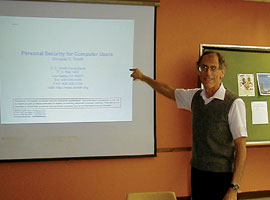 |
| Doug Smith visits the Los Angeles
Chapter in October to present "Personal Security for
Computer Users" to a curious audience. |
testing expertise. He provided useful insights into EMC modeling
that can guide those just starting in modeling and help fine tune
the insight of the experienced EMC modelers. The Chapter took
a long break from June to October as we had several speakers get
cold feet when it came to air travel in the post September 11th
era. Our final meeting for 2002 was in October. The subject, Computer
Security, was a refreshing change of pace for the hard core EMC'ers
in the group. The presentation was entitled "Knock in the
Middle of the Night" which was a real eye opener in this
day and age of the computer hacker. Doug Smith presented the audience
with useful information on firewalls, sample computer attacks
from the victim computer perspective and how you can make it harder
for hackers to invade your home PC by changing some of the settings
in your Internet browser. He also told us of a free firewall program
that can be downloaded off the Internet. The Los Angeles Chapter
is looking forward to a better year in 2003 and is already planning
to top the 2002 program of events.
 |
| Dave Simons, Los Angeles Chapter
Student Activities Chair, Ray Adams and speaker Robert Reynolds
after the PIM Tutorial. |
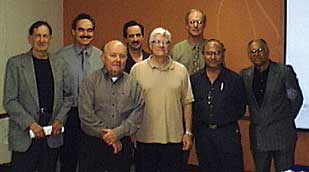 |
| Los Angeles Chapter "Groupies"
(first row left to right) Dave Simons (Student Activities
Chair), Ken Loy (TRW), Richard Mahoney (Aerospace), Richard
Briet (Aerospace) and Kanaiya Mahendra (Aerospace). (Second
row left to right) John O'Brien (WEMS Electronics), Ray Adams
(Boeing) and Robert Reynolds (Boeing). |
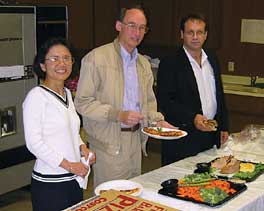 |
| Terri He (Boeing), Brian Kuhlman
(Boeing) and John Wiggans (Consultant) enjoyed the social
hour prior to the meeting of the Los Angeles EMC Chapter. |
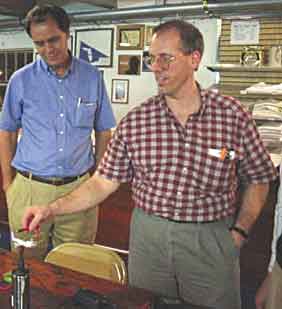 |
| The Melbourne Chapter gets a "hands
on" opportunity to better understand aircraft lightning
attachment phenomenon. |
Melbourne
On December 5, 2002, the Melbourne, Florida EMC Chapter hosted
a technical meeting to discuss certification of commercial aircraft.
Edward Kirchner and Bruce Crain, both employed by Northrop Grumman
in Melbourne, Florida presented "FAA Certification for Electromagnetic
Environmental Effects." Ed and Bruce have many years of experience
in EMC aircraft design, and Bruce is a FAA Designated Engineering
Representative for EMI, EMC, HIRF, and Lightning protection. The
meeting was held at the Indian River Brewing Company in Melbourne,
Florida home of the (soon to be) world famous Kelly's Cider. After
everyone had their fill of pizza and samples of the house beverage,
the guests were treated to the technical presentation in big screen
and amplified sound, thanks to a donation from the EMCS Angel
Fund that purchased some much-needed audio/visual equipment. After
the presentation, aircraft lightning attachment phenomenon were
demonstrated using a model airplane set atop a high voltage generator
(thanks to Fred Heather of NAWCAD for providing the inspiration
for this demo!). This meeting was a great way to end the Melbourne
Chapter's 2002 activities, and we look forward to another successful
year in 2003.
Mohawk Valley
After a summer hiatus, the Mohawk Valley Joint EMC/Reliability
Chapter went into full gear sponsoring two speaking engagements,
one by Dr. Lothar (Bud) Hoeft on "A View of Electromagnetic
Life above 100 MHz" in October and a second by Dr. John D.
Norgard on "Infrared Images of Electromagnetic Fields (Radiation/Scattering/Coupling)"
in December. Many thanks to Chapter Chair Irina Kasperovich of
ANDRO Computational Solutions in Rome, NY for arranging these
talks. In October Dr. Hoeft, an EMC Society Distinguished Lecturer
and a Consultant in electromagnetic effects out of Albuquerque,
New Mexico, gave a talk on the electromagnetic impacts of high-speed
digital electronics and advanced telecommunications technologies,
in particular, at frequencies above 100 MHz. He points out that
above 100 MHz, many of the usual simplifying assumptions that
EMC engineers apply
 |
| Chapter Chair Irina Kasperovich welcomes
Dr. Norgard to the Mohawk Valley. |
are no longer true and engineers must adopt a new way of looking
at EMC problems. Dr. Hoeft suggests an intuitive approach be adopted
that allows the engineer to visualize a "circuit/system"
as a collection of components whose characteristics can be estimated,
or if necessary, measured. Parasitic effects, absorption, radiation
losses, and wavelength effects become more significant above 100
MHz, yet these effects can be overlooked in the larger sense.
As Dr. Hoeft puts it, "…life is 'absorbing' above 100
MHz," that is, most losses are proportional to some power
as a function of frequency, therefore, they can become dominant
effects at the higher frequencies. Another way of visualizing
the circuit/system problem is to use the acoustic to electromagnetic
wave analogy. Because of the differences in the propagation velocity,
most things in life are acoustically small and they scatter, interact
and absorb acoustic energy in a way that is analogous to how they
react to electromagnetic energy. Dr. Hoeft gave a most stimulating
talk on this subject.
The December presentation by Dr. Norgard, who is an IEEE Fellow
(for Infrared Metrology) and a Professor of the ECE Department
at the University of Colorado at Colorado Springs as well as a
Visiting Professor at the US Air Force Academy in Colorado Springs,
discussed the development of a new method for measuring the magnitude
and phase of electromagnetic fields using thermal techniques.
Incidentally, Dr. Norgard is a Member of the EMC Society Board
of Directors and is the new Vice-President for Technical Services.
According to Dr. Norgard, the technique allows for the direct
measurement of the magnitude of the field (by creating an IR thermogram),
and for the indirect measurement of the phase (by creating an
IR hologram). A brief outline of the theory was presented. In
generating an IR thermogram of the field, a thin, lossy IR detector
screen is placed in the plane over which the field is to be measured.
A sensitive IR camera is used to measure the small relative changes
in temperature over the surface of the screen on a pixel-by-pixel
basis. These temperature changes are due to the power absorbed
from the
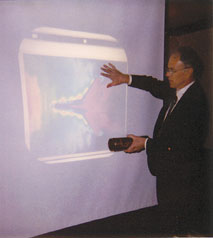 |
| Dr. Norgard describes his IR thermogram
for visualizing scattered EM fields. |
incident field by the lossy screen material and are proportional
to the intensity of the incident field at each pixel location.
The screen has been calibrated at NIST, Boulder to produce a "color
temperature" table vs. incident EM field intensity. Therefore,
the absolute field intensity can also be measured. When the IR
images are combined with holographic phase retrieval techniques,
the phase of the field can also be recovered from magnitude only
measurements. This technique has many advantages over conventional
hard-wired probe techniques, viz. speed and accuracy (no mutual
coupling), and produces a 2D visual image of the field being measured.
It is also well suited for measurements in small cavities without
the introduction of metallic probes that change the Q of the cavities.
The technique has been used previously to measure RF and microwave
fields and has been applied to many radiation, scattering, and
coupling problems. Dr. Norgard presented several examples of these
applications which are currently being used by the Government
and industry. His talk was very well received and Chapter Chair
Irina Kasperovich plans to invite Dr. Norgard back by demand,
to present the second half of this topic on "creating an
IR hologram" to analyze the phase properties of scattered
electromagnetic waves.
Ms. Kasperovich plans for additional Distinguished Lecturer (DL)
speaking engagements starting in Spring 2003. She noted, "The
DL Program has become an important tool in exposing our local
technical community to the importance of EMC and is an effective
way of serving our local Section and Chapter members as well as
for recruiting new members." More to come in the next Newsletter!
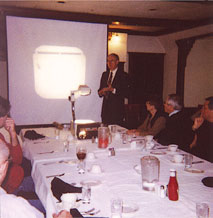 |
| An attentive audience
listens as Dr. Norgard explains his IR imaging technique. |
Nanjing
On November 1, the Nanjing EMC chapter held a meeting attended
by 9 IEEE members and 30 guests. Dr. Keren Li of the Communications
Research Laboratory gave a presentation entitled, "Photonic
Feeding Coplanar Antenna for Microwave and Millimeter Wave Applications."
Dr. Li's presentation was greatly appreciated by the large audience.
On November 14, Mr. Lin Jin, Senior Engineer with the Nanjing
Institute of Electronic Research, spoke to the chapter regarding
"Design of Planar Waveguide-Slot Array Antennas." An
outstanding turnout of 12 IEEE members and 43 guests very much
enjoyed Mr. Jin's presentation. "Antenna Technology for Beyond
3G Wireless Communications," was the hot topic for the December
12th meeting. Professor Wei Hong of Southeast University spoke
to large group of 14 IEEE members and 47 guests who very much
enjoyed his presentation. Only one day later, on December 13,
Professor Tie Jun Cui indulged a group of 52 engineers with a
very interesting report entitled, "Recent Progress on Computational
Electromagnetics." In a final meeting for 2002, the chapter
met on December 18 for a presentation by Professor Erik D. Goodman,
Michigan State University, entitled, "Automated Design of
Multi-Domain Dynamic Systems Using Evolutionary Algorithms."
The chapter meeting and presentation was thoroughly enjoyed by
10 IEEE members and 26 guests.
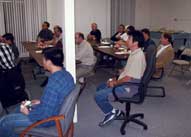 |
| Ed Nakauchi's October presentation
to the Orange County Chapter was well received. |
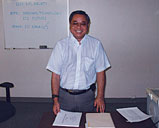 |
| Ed Nakauchi of Laird Technologies
prepares for his presentation to the Orange County Chapter
in August. |
Orange County
On October 29th the Orange County, California Chapter welcomed
Mr. Ed Nakauchi of Laird Technologies for a insightful presentation
on Shielding Technology and its future. Ed's presentation discussed
where today's technology is going with its faster clock speeds
and smaller sizes. Ed focused on how this technology would impact
the world of shielding and he presented solutions provided by
shielding companies such as the use of high frequency absorbers.
He also discussed the shortcoming of shielding theory that is
presently used today. We had an excellent audience of over 25
engineers to benefit from this presentation. On November 14th,
the Orange County Chapter welcomed Chris Kendall, CEO and Pricipal
Consultant at CKC Laboratories, for a special, three hour "Design
and Test for Immunity Workshop." We had an exceptional turnout
of over 45 attendees for this meeting! Mr. Kendall's presentation
featured design techniques for achieving required immunity, including
system grounding, I/O cable shielding and shield termination,
I/O filtering, PC board layout rules, PCB filtering rules, case
shielding requirements, clamping methods, RF common mode chokes,
and other design methods that have proved successful. It also
covered ESD theory (how ESD is generated and basic physics that
describe ESD including capacitance, impedance, charge, voltage,
current, and power), radiated immunity and conducted immunity.
The presentation was well received and many EMI engineers stayed
after the seminar to chat with Mr. Kendall. Many thanks to CKC
Laboratories' Brea, California laboratory for hosting both the
October and November meetings.
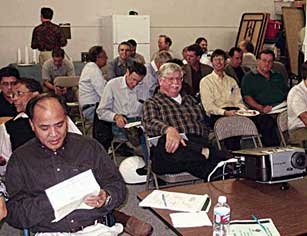 |
|
Attendees at the November Orange
County Chapter meeting await the start of Chris Kendall's
Immunity Workshop.
|
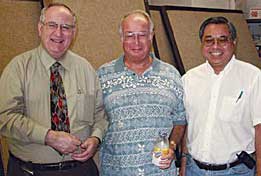 |
| The Orange County Chapter November
Speaker, Chris Kendall of CKC Labs, visits with local EMC
icons Michael King and Ed Nakauchi, from left to right. |
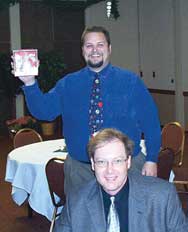 |
| Derick Skouby, Chapter Chair and
Dean Jurgensen, Chapter member, enjoyed the Oregon and SW
Washington Chapter winter social. |
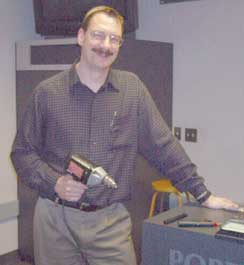 |
| Pat André demonstrates the
special "EMC" test tools that he discussed at the
Oregon and SW Washington Chapter meeting in November. |
Oregon and Southwest Washington
On October 30th, Greg Kiemel of Northwest EMC presented the topic
"EMC Authorization of Wireless Devices in the US and EU."
His interesting presentation generated several questions from
the audience. This timely topic was well received. On November
21st,
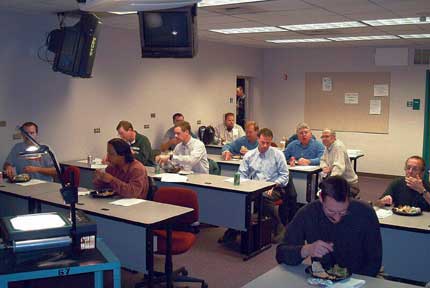 |
| The Oregon and SW Washington Chapter
enjoys dinner before Pat André's ". . . Drive
by EMC" presentation on November 21. |
Patrick André of André Consulting Inc. presented
the topic "Troubleshooting EMI, Even More Drive-By EMC Engineering."
His presentation utilized several special "EMC" test
tools as shown in his photographs. On December 12th, the Chapter
had our holiday social. This event was a combined social meeting
with the Product Safety Technical Committee (PSTC), which is affiliated
with the EMC Chapter. 30 revelers attended the event. All had
a delightful evening of dinner, dancing and gift exchanging. We
had some special guests from the EMCS international organization
at the event: Janet O'Neil and Barry Wallen. Our 2003 schedule
includes Dennis King of FerriShield presenting on "Ferrites
and EMC" in January. In February, we are looking forward
to having Distinguished Lecturer, Bruce Archambeault, do a presentation
on modeling. On March 24th, the chapter will sponsor a colloquium
and exhibition. This year we are honored to have Lee Hill of Silent
Solutions LLC and Tom Van Doren of the University of Missouri,
Rolla as our speakers. We anticipate very good attendance at this
ever-popular biennial event. In April, we will have Bruce Harlacher
of Fischer Custom Communications presenting on the new requirements
in CISPR 22, paragraph 9.5, concerning conducted emissions on
telecom ports using Impedance Stabilization Networks (ISN's).
In May, we have Distinguished Lecturer CW Lam of Apple Computer
scheduled for a presentation. Details of these events can be found
on our chapter web site at https://www.worldaccessnet.com/~emc/.
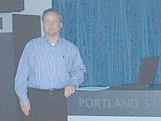 |
| Greg Kiemel gives an informative
presentation on the approval of transmitters to the Oregon
and SW Washington Chapter. |
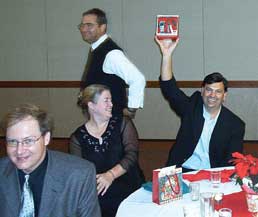 |
|
Dean Jurgensen, Jacque
Benitez, Barry Wallen and Henry Benitez get into the holiday
spirit at the Oregon and SW Washington winter social event.
|
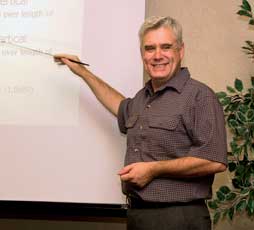 |
| At the Phoenix Chapter meeting, Distinguished
Lecturer Colin Brench points out the 14 dB variation of field
strength across the length of a dipole versus the 3dB of field
variation across a bi-conical antenna. |
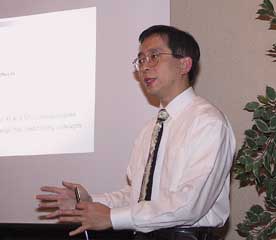 |
| Distinguished Lecturer
Dr. Cheung-Wei Lam points out to Phoenix Chapter members that
signal integrity (SI) is usually focused in the time domain,
while EMI is typically focused in the frequency domain. |
Phoenix
At the October 10th meeting, Terry Donohoe announced that he was
stepping down as Chapter Chairman. The Chapter formally recognized
Terry for his outstanding contributions in the past four years.
After a rousing social hour at Garcia's Mexican restaurant in
the Embassy Suites Tempe, Harry Gaul was unanimously elected by
all members present to take Terry's place as Chairman. Harry will
also continue to act as the Treasurer and Webmaster. Glen Gassaway
was then elected by the membership to fill the secretary position,
at least temporarily. Daryl Gerke was re-elected as vice-chairman.
After our business was completed, it was time to start the presentation.
Colin Brench, Principal Member of the Technical Staff at Hewlett-Packard
in the Boston area, presented "Antenna Behavior and Use -
(What Really Goes On During a Test?!)" Colin delivered a
remarkable presentation highlighting the differences between the
ways the antennas are designed, used and calibrated. The presentation
included a wealth of anecdotal information, test data, and empirical
results that indicated potential errors when certain antennas
were used in certain ways. This issue is further confused by the
international requirements that must be met when both qualifying
an EMC test site and the theoretical models which still have their
own inaccuracies. One of the highlights of the meeting was Colin's
mentioning that some businesses strive for 6-Sigma accuracies
while the accuracy actually established through EMC measurements
was calculated by him at one time to be approximately 1-Sigma.
This caused a few laughs, as this simple mention of 6-Sigma caused
many of the meeting participants from the larger companies to
generate loud noises. After the presentation, Harry presented
Colin with the traditional jar of Arizona salsa for a job well
done. Thanks from all of us, Colin! At the November 21st meeting,
Dr. Cheung-Wei Lam of Apple Computer presented "Signal Integrity
Design versus Radiated Emission Control," where his goal
was to highlight the relationship between the two subjects. His
presentation was organized into four parts: design objectives,
key concepts, design considerations and a summary. Dr. Lam pointed
out that signal integrity (SI) was usually focused in the time
domain, while EMI was typically focused in the frequency domain.
He mentioned that common mode emissions are the biggest concern
for EMI and these can be estimated using a dipole antenna model.
Oftentimes, it is the ground structure that is the biggest item
that can radiate, and it is imperative that radiators (such as
the CPU and heat sink assembly) must be kept away from the center
of the PWB and away from the I/O. Dr. Lam then fooled everyone
with a question asking whether a microstrip or co-planer strip
transmission line is the larger radiator; the answer was, "it
depends!" In the differential mode, the coplanar strip radiates
less, while the microstrip radiates less common mode. He told
us that ground drop is a major source of radiation and a design
practice would be to focus on reducing di/dt and ground inductance.
Dr. Lam then spoke of situations where good SI design practice
helps EMI. These situations included: good ground planes; source
vs. end resistive termination of traces; paying careful attention
of continuous impedance matching of traces; proper handling of
stubs, vias and return vias; crosstalk (especially from clocks
to I/O); traces crossing slots; connectors and IC pinouts; board
stack-up and placement; the use of differential signaling; and
proper power decoupling. Whew! He also mentioned areas where EMI
design practices do not have a significant effect on EMI, including
splitting clock frequencies, shielding, some forms of grounding,
and the minimization of fringing fields by not running critical
traces near board edges. Dr Lam then covered areas where good
EMI design can actually hurt SI, including filtering of I/O's
and clocks, spread spectrum clocking, burying clock layers and
skin and dielectric losses. He also mentioned areas where good
SI design can hurt EMI, including ground isolation techniques,
and timing driven designs (e.g. traces made longer than they have
to be). Dr. Lam then summarized this wealth of information, and
received several compliments from the crowd in making such a complex
subject more easily understood! Information on upcoming meetings
is available at the Chapter's web site, https://www.ewh.ieee.org/r6/phoenix/phoenixemc/.
Romania
Chapter Chatter has learned that a new EMC chapter was formed
last month. In a letter dated November 19, 2002, the IEEE informed
Andrei Marinescu, Interim Chapter Chair, that the IEEE by-laws
had been met and that a new EMC chapter had been formed under
the Romanian section of the IEEE. Congratulations to the new Chapter
and we hope to hear from them soon!
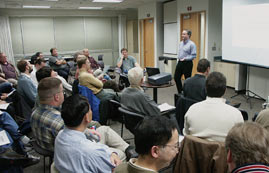 |
| Greg Kiemel of Northwest EMC delivered
a great presentation to a full house at the November Seattle
Chapter meeting. |
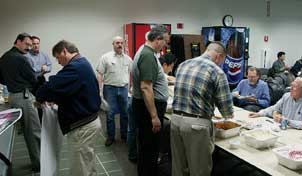 |
| Seattle Chapter members
were treated to a catered dinner from Tony Roma's courtesy
of Northwest EMC prior to the November meeting. |
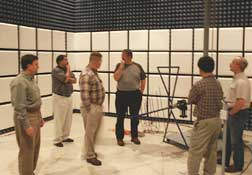 |
| A tour was conducted of the EMC laboratory
at Netro Corporation, site of the November Seattle Chapter
meeting. |
Seattle
The October 23rd Chapter meeting was held at the Meydenbauer Center
in Bellevue, in conjunction with the Northcon conference that
took place there from October 22-24. Prior to the meeting, the
IEEE Seattle Section provided complimentary gourmet pizza, draft
beer and wine at an informal reception in the exhibits area. Chapter
members were able to mingle with the exhibitors and stroll through
the exhibits while enjoying a tasty dinner. The Chapter meeting
speaker was Colin Brench of Hewlett Packard in Marlborough, Massachusetts.
Colin came to town to participate as a speaker at Northcon. He
gamely stayed longer and spoke to the Chapter as well on "Antenna
Behavior and Use - (What Really Goes on During a Test?!)".
The topic inspired the Chapter members to stay and ask several
questions at the end. It was a lively meeting with much interaction
between the speaker and the attendees. There was even an antenna
on display to complement the material presented: a demo EMCO biconical
antenna and tripod from the Chapter Chair's office which was gamely
brought to the meeting. (Many thanks to Colin for helping transport
these to the meeting room and for setting them up in record time!)
Mr. Brench really had a busy week at Northcon! 27 people attended
his full day course on "EMC Essentials" and 17 attended
his half-day course on "EMC Computer Modeling." Incidentally,
Chapter officers Pat André and Kitty Tam attended these
courses, respectively. Despite the depressed economy, there was
a good turn out at Northcon last year. For its November meeting,
Chapter Vice-Chair Pat André reports that the Seattle Chapter
was delighted to feature Greg Kiemel of Northwest EMC. Mr. Kiemel
spoke on the topic "Agency Certifications Explained."
He gave a lively discussion on the present state of the submittal
process for the FCC, Europe, and other areas around the world.
Concerning the FCC, Greg showed the step-by-step process for certification,
the changes in the process over the years, and the types of equipment
requiring certification. He discussed the roll of a TCB (Telecommunication
Certification Bodies) in the U.S. and in Europe, and the advantages
of them. He also discussed MRA's (Mutual Recognition Agreements),
TCB activities and prohibitions. Greg then discussed the European
R&TTE (Radio and Telecommunications Directive) philosophy
and activities. This branched into a discussion on Notified Bodies
and Conformity Assessment Bodies (CAB's). This included when to
use a Notified Body, who is one, and what information do they
need from you. He ended with a number of web links where further
information can be found. The presentation went 90 minutes, and
was continuously lively, interesting and informative. Questions
were fielded and answered throughout the evening. Some of the
best conversations were between Greg and the FCC representative
in the audience. Many thanks to Northwest EMC for hosting the
dinner catered by Tony Roma's prior to the November Chapter meeting.
 |
| EMC Society Distinguished Lecturer
Colin Brench spoke at the October Seattle Chapter meeting.
He was obviously pleased with how well his presentation was
received! |
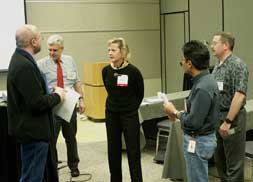 |
| Seattle EMC Chapter Chair Janet O'Neil
visits with speaker Colin Brench and chapter members following
the October meeting. |
Singapore
The Singapore EMC Chapter held a meeting on December 12th at the
Institute of High Performance Computing (IHPC). Dr Bruce Archambeault
of IBM (Research Triangle Park, North Carolina) spoke at the early
afternoon meeting on the topic of "EMI/EMC Modeling and Simulation
for Real World Applications." The meeting was well attended
by approximately 12 members and 60 non-members. Bruce briefed
the audience about the rationale and methods behind the application
of Computational Electromagnetics. He spoke on what these methods
could and could not achieve. The Singapore Chapter would like
to thank the Institute of High Performance Computing for their
generosity in hosting the meeting. We have made plans to host
the next meeting in the latter part of January 2003. Contact Tim
Foo (email: fwj@np.edu.sg)
for the latest schedule on the upcoming chapter meetings of the
Singapore chapter.
 |
| Those in attendance at the December
Singapore Chapter meeting included (from left) Li Er Ping
EMC Divisional Manager, CEM & Electronics IHPC Singapore
(Chapter Deputy Chair), Tim Foo Ngee Ann Polytechnic (Chapter
secretary), speaker Bruce Archambeault, and Ng Buck Chew (Chapter
committee member). |
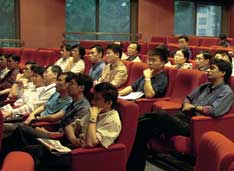 |
| Participants listening eagerly to
Bruce as he spoke about CEM at the Singapore Chapter meeting. |
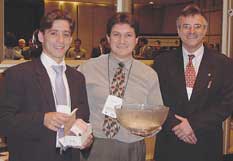 |
| A raffle for a free probe, courtesy
of Credence Technologies, was held during the reception following
EMC Brasil 2002. Antonio Caramico, Jr. of Rohde & Schwarz
won the prize and received congratulations from Toni Gurga
of Credence and Carlos Sartori from the University of São
Paulo (from left). |
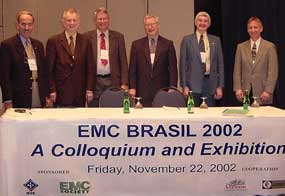 |
| It's an all-star line up of speakers
for EMC Brasil 2002, including (from left) Jose Perini, Don
Heirman, Ghery Pettit, Dan Hoolihan, Elya Joffe, and Todd
Hubing. |
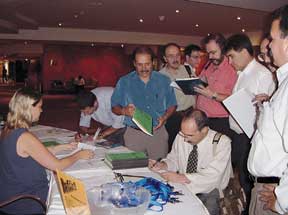 |
| Mônica de Amorim Schutt from
the University of São Paulo ably handled the registration
rush prior to the start of EMC Brasil 2002. |
South Brazil
"It's Caipirinha time!" so exclaimed the attendees following
"EMC Brasil 2002." This Colloquium and Exhibition was
held on Friday, November 22 in São Paulo, Brazil at The
Renaissance Hotel. Over 75 people attended the full day of technical
presentations. At the end of the day, a reception was held with
the speakers and exhibitors who were on hand to showcase the latest
and greatest in EMC products and services. Caipirinhas, the national
drink of Brazil, were following freely from the bar during the
reception. And why not? All agreed the event was very successful
and there was reason to celebrate! Benjamim da Silva Medeiros
C. Galvao from the Instituto Nacional de Pesquisas Espaciais (INPE
- The Brazil Space Agency) commented: "Not only was it a
great day to learn more about EMC from knowledgeable experts in
the industry, but the event also provided the opportunity to network
with one's colleagues and informally meet with the exhibitors."
This event was sponsored by the EMC Society South Brazil Chapter
and was organized by Janet O'Neil of ETS-Lindgren and Professor
Carlos Sartori of the University of São Paulo. Professor
Sartori was ably assisted by members of his University as well.
The colloquium speakers included members of the IEEE EMC Society
Board of Directors: Don Heirman of Don HEIRMAN Consultants on
"Global EMC Emission Standards," Ghery Pettit of Intel
on the "Worldwide Approval Process" (especially as related
to ITE), Todd Hubing of the University of Missouri-Rolla on "Practical
Design Techniques for Printed Circuit Boards," Dan Hoolihan
of Hoolihan EMC Consulting on "EMC Test Methodology and Site
Considerations," Jose Perini of Syracuse University, New
York providing an "Overview of Numerical Methods," and
Elya Joffe of KTL Project Engineering on "EMC Considerations
in On-Board System Integration." It was a great line-up of
internationally known experts in the EMC community.
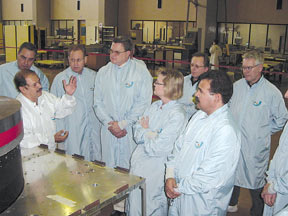 |
| The day prior to EMC Brasil 2002,
participating exhibitors and members of the EMC Society Board
of Directors were invited to tour INPE. Benjamim da Silva
Medeiros C. Galvao of INPE (far left with raised hand) is
shown conducting this tour. |
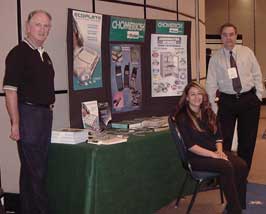 |
| Tabletop exhibitors at EMC Brasil
2002 included Chomerics. Their display was manned by (from
left) Steve Mullenix, Maria Cristina Gomes and Philippe Foister. |
 |
| Southeastern Michigan Chapter members
(from left) Chuck Blahunka of Hitachi, Jacob Alkalay of Ford
Motor Company, Poul Andersen of DaimlerChrysler (rear) and
Steve Laya of Elite Electronic Engineering enjoyed the networking
following the November meeting. |
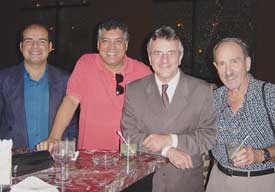 |
| Cassius Clay Cardoso da Silva and
Professor J. R. Cardoso, head of the Lmag/PEA University of
São Paulo "Applied Electromagnetics Laboratory,"
join fellow Brazilians Carlos Sartori and Jose Perini (left
to right) following the EMC Brasil 2002 event. |
Southeastern Michigan
On November 6, 2002, the Southeastern Michigan IEEE EMC Society
Chapter meeting was held at X2Y Attenuators' new facility in Farmington
Hills, Michigan. James Muccioli served as the meeting host and
Scott Lytle was the presiding Chapter officer. The IEEE meeting
was preceded by the SAE EMI Standards committee meeting, so several
SAE members stayed for the IEEE meeting. In all, 28 people attended
the presentations by Terry North of DaimlerChrysler and James
Muccioli of X2Y Attenuators. Terry presented "DaimlerChrysler
EMC Performance Requirements Changes Overview" which covered
the many changes to the new DaimlerChrysler EMC testing specifications.
This was a condensed version of the six-hour presentation at DaimlerChrysler
on November 11th. After Terry's presentation, we enjoyed pizza
and refreshments provided by Janet O'Neil from ETS-Lindgren. James
Muccioli concluded the evening by presenting "High Frequency
Motor Measurements in a GTEM" in the testing lab at X2Y.
Jim used his "Hummingbird" GTEM cell where he demonstrated
various filters that help reduce emissions from DC motor brushes.
More information about the Chapter may be found on the Southeastern
Michigan IEEE EMC Society website at https://www.emcsociety.org.
 |
| Southeastern Michigan Chapter Chair
Scott Lytle of Yazaki North America is shown with the speakers
at the November meeting, including Terry North of DaimlerChrysler
and Jim Muccioli of X2Y Attenuators (left to right). |
Toronto
The Toronto Chapter held a meeting on November 15th, 2002 at the
St. George Campus of the University of Toronto. The speaker for
the meeting was IEEE AP Society Distinguished Lecturer, Dr. Zoltan
Cendes, Founder and Chairman of Ansoft Corporation. The title
of his presentation was "High-Level Design Using Coupled
Electromagnetic, Circuit and System Simulation" and was enjoyed
by all in attendance. EMC
 Chapter
Chatter
Chapter
Chatter 







































